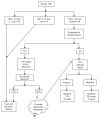Treatment for primary hypothyroidism: current approaches and future possibilities
- PMID: 22291465
- PMCID: PMC3267517
- DOI: 10.2147/DDDT.S12894
Treatment for primary hypothyroidism: current approaches and future possibilities
Abstract
Primary hypothyroidism is the most common endocrine disease. Although the diagnosis and treatment of hypothyroidism is often considered simple, there are large numbers of people with this condition who are suboptimally treated. Even in those people with hypothyroidism who are biochemically euthyroid on levothyroxine replacement there is a significant proportion who report poorer quality of life. This review explores the historical and current treatment options for hypothyroidism, reasons for and potential solutions to suboptimal treatment, and future possibilities in the treatment of hypothyroidism.
Keywords: levothyroxine; primary hypothyroidism; thyroid; thyroid-stimulating hormone; triiodothyronine.
Figures

Similar articles
-
Thyroid function status in patients with hypothyroidism on thyroxine replacement and associated factors: a retrospective cohort study in primary care.BMC Prim Care. 2024 Oct 26;25(1):383. doi: 10.1186/s12875-024-02613-z. BMC Prim Care. 2024. PMID: 39462347 Free PMC article.
-
Hypothyroidism in the elderly: pathophysiology, diagnosis and treatment.Drugs Aging. 2005;22(1):23-38. doi: 10.2165/00002512-200522010-00002. Drugs Aging. 2005. PMID: 15663347 Review.
-
[Thyroid hormone treatment].Dtsch Med Wochenschr. 2013 Jul;138(27):1413-20; quiz 1421-4. doi: 10.1055/s-0032-1327385. Epub 2013 Jun 25. Dtsch Med Wochenschr. 2013. PMID: 23801264 German.
-
Hypothyroidism: etiology, diagnosis, and management.Med Clin North Am. 2012 Mar;96(2):203-21. doi: 10.1016/j.mcna.2012.01.005. Epub 2012 Feb 14. Med Clin North Am. 2012. PMID: 22443971 Review.
-
Risks and safety of combination therapy for hypothyroidism.Expert Rev Clin Pharmacol. 2016 Aug;9(8):1057-67. doi: 10.1080/17512433.2016.1182019. Epub 2016 May 9. Expert Rev Clin Pharmacol. 2016. PMID: 27137849 Review.
Cited by
-
Thyroid function status in patients with hypothyroidism on thyroxine replacement and associated factors: a retrospective cohort study in primary care.BMC Prim Care. 2024 Oct 26;25(1):383. doi: 10.1186/s12875-024-02613-z. BMC Prim Care. 2024. PMID: 39462347 Free PMC article.
-
Investigation the effect of a herbal composition based on blackseed on patients with primary hypothyroidism: A randomized controlled trial.Avicenna J Phytomed. 2024 May-Jun;14(3):325-337. doi: 10.22038/AJP.2024.23984. Avicenna J Phytomed. 2024. PMID: 39086868 Free PMC article.
-
Health-related quality of life and its association with the symptom score and the thyroid function status of patients with primary hypothyroidism on replacement therapy.J Family Community Med. 2023 Oct-Dec;30(4):280-286. doi: 10.4103/jfcm.jfcm_103_23. Epub 2023 Oct 13. J Family Community Med. 2023. PMID: 38044967 Free PMC article.
-
Levothyroxine liquid oral substitution as an alternative treatment for refractory hypothyroidism due to gastrointestinal malabsorption: A case report.SAGE Open Med Case Rep. 2023 Nov 2;11:2050313X231209229. doi: 10.1177/2050313X231209229. eCollection 2023. SAGE Open Med Case Rep. 2023. PMID: 37927364 Free PMC article.
-
Development of a quantitative thyroid-stimulating hormone assay system for a benchtop digital ELISA desktop analyzer.Front Bioeng Biotechnol. 2023 Sep 21;11:1227357. doi: 10.3389/fbioe.2023.1227357. eCollection 2023. Front Bioeng Biotechnol. 2023. PMID: 37811377 Free PMC article.
References
-
- Hollowell JG, Staehling NW, Flanders WD, et al. Serum TSH, T(4), and thyroid antibodies in the United States population (1988 to 1994): National Health and Nutrition Examination Survey (NHANES III) J Clin Endocrinol Metab. 2002;87(2):489–499. - PubMed
-
- Vanderpump MP, Tunbridge WM, French JM, et al. The incidence of thyroid disorders in the community: a twenty-year follow-up of the Whickham Survey. Clin Endocrinol (Oxf) 1995;43(1):55–68. - PubMed
-
- Leese GP, Flynn RV, Jung RT, Macdonald TM, Murphy MJ, Morris AD. Increasing prevalence and incidence of thyroid disease in Tayside, Scotland: the Thyroid Epidemiology Audit and Research Study (TEARS) Clin Endocrinol. 2008;68(2):311–316. - PubMed
-
- Tunbridge WM, Evered DC, Hall R, et al. The spectrum of thyroid disease in a community: the Whickham survey. Clin Endocrinol. 1977;7(6):481–493. - PubMed
-
- Laurberg P. Global or Gaelic epidemic of hypothyroidism? Lancet. 2005;365(9461):738–740. - PubMed
Publication types
MeSH terms
Substances
LinkOut - more resources
Full Text Sources
Other Literature Sources
Medical


